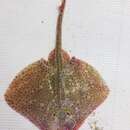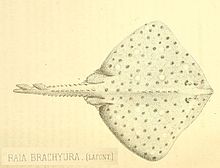en
names in breadcrumbs


The blonde ray or blonde skate (Raja brachyura) is a species of ray fish in the family Rajidae.[2][3]

The Blonde ray lives in the Eastern Atlantic Ocean, at depths of 10–380 m. It is found occasionally in the Mediterranean Sea as well.[5] Blonde rays look like what you would expect from their name. Light brown with a few creamy-white blotches and dense dark spots which extend up to the very edge of the disc and on the tail [6]
Like all rays, the blonde ray has a flattened body with broad, wing-like pectoral fins. The body is kite-shaped with a short tail (hence the specific name brachyura, from Ancient Greek words meaning "short tail").They are found anywhere from the western isles of Scotland to Morocco and can be found in the northern and western Mediterranean.
Maximum length is 120 cm (47 in).[7]
Blonde rays are considered bottom dwelling species that like more sandy and muddy areas. As with many elasmobranch species, shallower coastal waters are used as nursery areas leading to a greater number of rays found near shore being juveniles.[8]
The diet of a blond ray consist of cephalopods, small bony fish and shrimp. Crangon crangon are a common prey in the rays diet. Both juvenile and adult rays feed on indiscriminate shrimps, prawns and crustaceans.[8]
Oviparous, with embryos feeding only on yolk. Blonde rays reaches sexual maturity at 85–92 cm in length, which corresponds to ~8–10 years of age.[9] The females tend to lay their eggs during the months of February and August and will lay a clutch size of around 40-140 eggs.[10][11]
The blonde ray matures in stages. These stages for males include juvenile, adolescent, adult mature and adult running. For females, the stages are different due to female rays laying eggs. The maturity phases for female rays include juvenile, adolescent, adult developing, adult mature, adult laying and adult resting. In males, claspers are the rays’ pelvic fins and are located on the inner margin of the pelvic fins. They are used to transport sperm into the female ray. As male rays age and go into different maturity levels, their claspers along with reproductive organs; like the testes; develop further until they hit the maturity phase of adult running. Average lifespan for a blonde ray average around 15 years. For female rays, we see the maturity of the ovaries. Like development in males with the claspers, the ovaries of the female will develop as the ray gets older and will stop maturing once the ray finishes laying eggs and reaches adulting resting phase where egg production decreases. Many R. brachyura tend to be around 92 cm in length at maturity and around the age of 10. Egg/year tend to be around 40-90 at this maturity age and length.[11]
Blonde rays are currently fished for human consumption, with a record weight of 37 lb (17 kg) recorded in Cobh, Ireland in 2008.[12][13] Skates (Rajidae) are often considered vulnerable to overfishing because they are long-lived, slow-growing, late to mature and produce few young, which, coupled with their generally large size, morphology, and aggregate-ing nature, renders them susceptible to capture in many fisheries.[14] With this, growing patterns and age of maturation phases are impacted. While most exploited commercial fish’s population decreases, the aggregated landings of rays, although variable, have remained relatively stable over the past 60 years.[15][16][17] However, human impact still effects the blond ray. These rays tend to be sought after for hunting usage. Along with being a trophy fish, they are also fished for food and are a popular dish in the UK. Due to them being commonly found in shallower water, it is easier for them to be caught. As a results, juveniles can be fished before they have had a chance to breed.[18]
Genetic disorders like Leucitic and Albinism are found to affect Blonde Rays. Leucitic disorder tend to cause the blonde ray to go from their normal brownish appearance with darker spots to white with black spots and tend to be smaller than normal. In Albinism, we see a predominately white dorsal side with little to no spots and eye color change. No physical damages or disease was shown to be increased in Blonde Rays with these genetic disorders.[19]
The blonde ray or blonde skate (Raja brachyura) is a species of ray fish in the family Rajidae.
 1873 sketch by the describer, A. Lafont
1873 sketch by the describer, A. Lafont  Scientist releasing a tagged blonde ray during fieldwork
Scientist releasing a tagged blonde ray during fieldwork